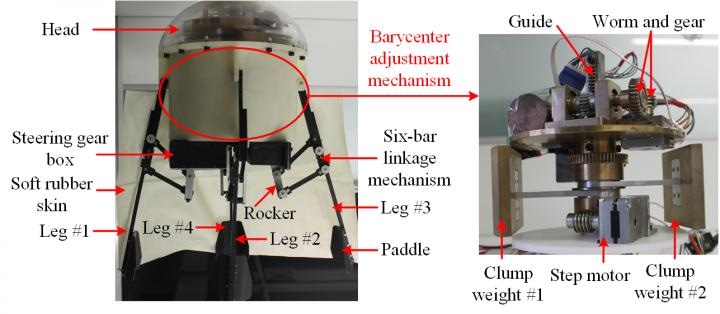Aug 6 2019
As a source of stimulus, aquatic creatures such as fish, jellyfish, and cetaceans could inspire advanced designs to enhance the ways that manmade systems work in and interact with aquatic environments. Jellyfishes in nature push themselves through their environs by radially expanding and contracting their bell-shaped bodies to force water behind them, which is called jet propulsion.
 This is the mechanical design of the robotic jellyfish. (Image credit: ©Science China Press)
This is the mechanical design of the robotic jellyfish. (Image credit: ©Science China Press)
In contrast to the prevalent view that jellyfishes are illustrated as inefficient swimmers, jellyfishes have been established to be one of the most dynamically efficient swimmers. That is, it specifies that jellyfish-like swimming will have an extraordinary propulsive advantage if low-energy propulsion is necessitated. Thus, the movements of jellyfish have garnered substantial interest over the past several years in the context of bio-inspired underwater vehicle.
Recently, scientists from the Institute of Automation, Chinese Academy of Sciences in Beijing, China effectively developed an innovative robotic jellyfish able to carry out 3D jellyfish-like propulsion and maneuvers based on a reinforcement learning-based technique.
Incorporating the latest progress in materials, mechatronic design, electronics, and control techniques, scientists are making a combined effort to build smart actuators to fabricate different robotic jellyfishes. Generally, such robotic jellyfishes are mostly tethered and much slower in speed compared to the kind actuated by conventional electric motors. Most of the current robotic jellyfishes cannot spontaneously regulate their three-axis attitude, which has an unfavorable effect on free-swimming propulsion and acceptable applications.
To solve this issue, the research team headed by Prof. Junzhi Yu from Institute of Automation, Chinese Academy of Sciences has explored how a bio-inspired motor-driven jellyfish-like robotic system capable of 3D motion is engineered and regulated.
The designed robotic jellyfish modeled after Aurelia aurita (generally termed moon jellyfish), which has a comparatively large displacement and is particularly well-matched for use with large load capacity. It is approximately 138 mm in height and weighs about 8.2 kg. The robotic jellyfish is hemispherical in shape and comprises a cylindroid main cavity, four separate six-bar linkage mechanisms, a bell-shaped rigid head, and a soft rubber skin.
To improve the robotic jellyfish’s maneuverability, a barycenter adjustment mechanism set up within the cavity is added. By modifying two clump weights in horizontal or vertical direction or in a combination of the two, the attitude regulation is achieved.
It is very hard to establish a precise dynamic model for jellyfish-like swimming, since it is a highly nonlinear, strong coupling, and time-varying system. Parametric uncertainties and external disturbances in dynamic aquatic environments, at the same time, cause difficulty in deriving control laws by solving the inverse kinematics problem.
Junzhi Yu, Professor, Institute of Automation, Chinese Academy of Sciences
Therefore, a reinforcement learning-based closed-loop attitude control technique is suggested for the robotic jellyfish, which can solve an ideal decision control problem through direct interaction with the environment, especially without needing dynamic modeling.
Lastly, the suggestion of the reinforcement learning-based attitude control technique makes autonomous attitude regulation feasible.
In comparison with most of the other robotic jellyfish, the built robot displays a high order of structure flexibility and yaw maneuverability.
Junzhi Yu, Professor, Institute of Automation, Chinese Academy of Sciences
He also highlighted that this self-propelled robotic jellyfish with 3D motion has significant implications for bio-inspired design of jet propulsion system with considerable agility.